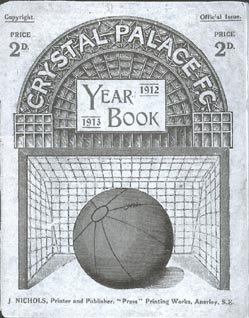Distant Memories: Palace captain Harry Hanger heads goalwards in the Southern League encounter with Swindon at the Crystal Palace during October 1913
(P134) BACK HOME?
Croydon Advertiser 30 January 2004 - Sport & Classified section (front page)
AFTER 80 years at Selhurst Park, the Eagles are contemplating a move back to their roots in Crystal Palace.
A relocation to a redeveloped stadium at the National Sports Centre site could take place in roughly six years, when the club's current lease at Selhurst expires, if talks between the clubs, Croydon Council and the London Development Agency bear fruit.
Even the most ardent Palace supporter would admit that the Arthur Wait and Main stands of Selhurst Park have seen better days, and a move to a new ground, rather than redevelopment of the existing site has been mooted for some time.
Green field sites near the M25 have been discussed in the past but a return to Crystal Palace Park, where the club played their games between 1905 and 1915, would be a far more acceptable solution for the Majority of Eagles fans.
Distant Memories: Palace captain Harry Hanger heads goalwards in the Southern League encounter with Swindon at the Crystal Palace during October 1913
The fact that the freehold of Selhurst Park is still held by former Palace chairman Ron Noades rather than current incumbent Simon Jordan could also push the club towards a move away from SE25.
Poor transport links count against the National Sports Centre's development. However, plans are in place for a new Tramlink and the extension of the East London Line while Crystal Palace is one of the biggest bus interchanges in south London.
One group that will certainly benefit would be away fans who have in the past faced a long walk having alighted at Crystal Palace railway station in the mistaken belief that it was the nearest to Selhurst Park.
The Glaziers, as they then were, attracted crowds of 4,000 to Crystal Palace Park (CPP) as they made their way out of the Southern League Division Two in I906 and a record crowd of 35,000 turned up in the rain to see Palace hold an Everton side containing nine internationals to a draw in the FA Cup quarter final of 1907.
England and Scotland contested four Auld Enemy encounters at Crystal Palace between 1897 and 1909 while the ground held 20 FA cup finals from 1894 to I914. Crowds of around 40,000 flocked to the finals in the 1890s, although this number swelled to over 120,000 by 1913.
While the new ground won't match those figures, the CPP's capacity is expected to be more than Selhurst Park's 26400. The only concern for football would be the building of a running track between the pitch and stands, a feature that would inevitably lead to a loss of atmosphere. Manchester City have overcome this problem with the inclusion of retractable stands at their new City of Manchester stadium, although it remains to be seen if the same will happen at the CPP.
Another worry is the loss of identity that goes hand-in-hand with playing at a multi-sports complex. City may have got around the potential problem of a lack of atmosphere, but a brand new stadium does not always translate into success on the field. Other clubs however have been more successful.
Not a single Sunderland supporter will rue the day the club traded the dated Roker Park for the glorious Stadium of Light. Few associated with Derby County pine for the Baseball Ground compared with Pride Park.
The majority of Arsenal supporters are virtually counting down the minutes for when they can leave their compact Highbury home for the promise of the far more expansive and illustrious Ashburton Grove stadium.
Selhurst Park has witnessed many a famous night, but even blinkered Palace fans would acknowledge the stadium is trapped in a time warp. Compare the rickety stands and sub-standard facilities to other grounds both in the Premiership and the Nationwide League. Even Third Division Hull City have a state-of-the-art 25,000-seater arena in the shape of the KCC stadium.
If Crystal Palace are to be a top flight - if results follow the recent trend they might be one next season - then they deserve a Premiership stadium and a ground to be proud of. Bar a drastic overhaul of the current site, Selhurst Park doesn't fit the bill.
With the lease up in 2010, Palace don't want to tread some nomadic path as Charlton Athletic, Fulham and Wimbledon have done in recent seasons. The three London clubs al struggled to find suitable homes, with Wimbledon being forced to relocate to Milton Keynes.
Top of
page; Return
to Publications Index
Cryodon
Advertiser
1/2/04 Last updated 1/2/04

More information on football at The Palace : see
"To the
Palace for the Cup"
by Ian Bevan, Stuart Hibberd and Michael Gilbert (1999)